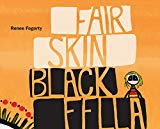
Title
Fair Skin Black Fella
Author
Renee Fogorty
Illustrators
Renee Fogorty
Publisher, Date
Magabala Books, 2010
Audience
3-4yrs, 5-8yrs, Lower Primary, Primary, Upper Primary
ISBN
9781921248146
Language
English, Wiradjuri language (D10) (NSW SI55-07)
Add to Favourites
-
Subjects
- Art motifs
- Art techniques
- Bullying
- Cultural diversity
- Culture
- Loneliness
- Race awareness
- Racism
- Skin colour
- Storytelling
- Wiradjuri people (D10) (NSW SI55-07)
-
Annotation
This picture book provides an important resource, for the home and classroom, to explore issues of racism and its impact on children. Readers of all ages will empathise with the likeable character of Mary - who is teased and alienated by the other children on the cattle station where she lives, and labelled a ‘half-caste’ because she is a Koori girl with fair skin. Mary’s feelings of sadness and isolation are vividly depicted, not only through the text, but through Renee Fogorty’s vibrant illustrations, which portray Mary sitting apart from the two girls who refuse to befriend her.
The role of Elders is illuminated in this book as Old Ned, one of the community Elders, explains to Mary and the two girls who have shunned her that we should embrace each other’s differences. We are reminded that Aboriginal culture has its origins in community and spirituality as Ned encourages the girls to bring ‘our culture and beliefs into the future.’
Yellow painted dots surround Mary and her two new friends, joining them together, as Renee Fogorty displays traditional Aboriginal art techniques in a contemporary way. Earthy tones of red, orange, brown and yellow are used throughout, highlighting the red and dusty setting of the cattle station.
Words from the Wiradjuri language are used sparingly throughout the text, such as Babeen (father) and Giwang (moon) - useful for opening up discussion about local Aboriginal languages. The themes of prejudice – and how it can occur not only between but within cultures – and acceptance of diversity, can be discussed in a home or classroom setting, along with the role of Elders, Aboriginal art techniques and culture, and ways of telling story.
Renee Fogorty is a young Wiradjuri woman from the Lachlan River region of New South Wales.
-
Teaching Resources
- Rebecca Cameron. YouTube. 'Reading of Fair Skin Black Fella by Renee Fogorty' https://www.youtube.com/watch?v=rW69VZnLfms
- Christina Wheeler. Magabala books – Teacher Notes.’ Fair Skin Black Fella: written and illustrated by Renee Fogorty.’ https://cdn.shopify.com/s/files/1/0092/5043/9268/files/Fair_Skin_Black_Fella_Teacher_Notes.pdf?2356
- Kids’ Book Review. Tania McCartney. 26 April 2010. ‘Review: Fair Skin Black Fella.’ http://www.kids-bookreview.com/2010/04/review-white-skin-black-fella.html
- Magabala Books. 'Teaching Indigenous Content – An Introduction.' https://www.magabala.com/pages/teaching-indigenous-content
- SBS – The Feed via YouTube. ‘Black Enough: living as a fair-skinned Indigenous person.’ https://www.youtube.com/watch?v=F269NJ0__L4
- Montessori Nature. ‘Australian Aboriginal Dot Painting for Kids and Art Resources.’ https://www.montessorinature.com/australian-aboriginal-dot-painting-for/
- Penn State Education. Better Kid Care. ‘Activities: We are different, we are the same: Teaching young children about diversity.’ http://bkc-od-media.vmhost.psu.edu/documents/Activities1506.pdf
- Australian Human Rights Commission. ‘Building Belonging: A toolkit for early childhood educators on cultural diversity and responding to prejudice.’ https://www.humanrights.gov.au/our-work/education/building-belonging-toolkit-early-childhood-educators-cultural-diversity-and
- ABC Education. Digibook. ‘Aboriginal Cultures: Sharing, connecting and practising.’ https://education.abc.net.au/home#!/digibook/3306855/aboriginal-cultures-sharing-connecting-and-practising
